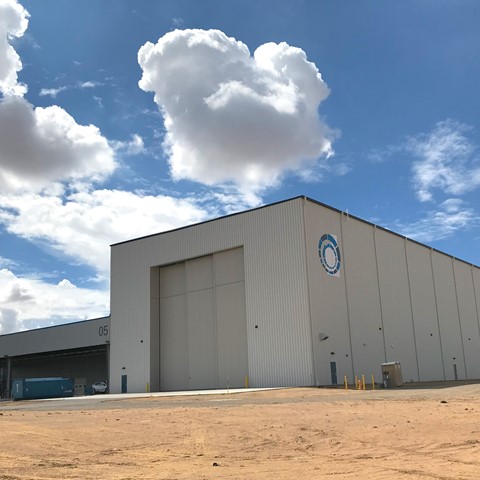We make use of cookies. When you click on agreed you are giving us your permission to do so. Please read our cookie statement for more information.
Kairos Power
Reactor Licensing Strategies and Implications for Fuel and Materials
02 September 2021
Kairos Power is a U.S.-based, clean energy engineering company developing the high-temperature, fluoride salt-cooled reactor (KP-FHR). Kairos Power’s mission is to enable the world’s transition to clean energy, with the ultimate goal of dramatically improving people’s quality of life while protecting the environment.
Emerging from a U.S. Department of Energy (DOE) sponsored integrated research project approximately four years ago, Kairos Power is working in several locations throughout the U.S. to commercialize the KP-FHR design. The company is privately funded, singularly focused, and fully committed to design, license, and demonstrate this technology through an iterative development and demonstration program. The schedule is to deploy a commercial reactor before 2030, with a significant ramp-up in deployment shortly thereafter.
While relatively young in the context of traditional nuclear development, Kairos Power’s iterative approach and strong emphasis on early engagement with the regulator have yielded significant experience and tangible licensing results early in the project lifecycle. Kairos Power’s near-term focus is on U.S. licensing and deployment, but the lessons learned through KP-FHR development, testing, and licensing experience are also valuable under different regulatory regimes.

Peter Hastings
Vice President, Regulatory Affairs and Quality

Micah Hackett
Director, Fuels & Materials
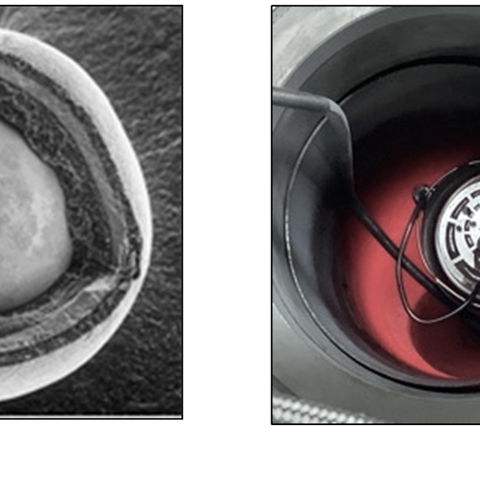
KP-FHR Technology
Kairos Power’s technology is based on the use of robust TRi-structural ISOtropic (TRISO) particle fuel, molten salt coolant (Flibe), and a low-pressure system, resulting in a substantial increase in margins of safety as compared to existing light-water reactors (LWRs), which are already among the safest form of energy production.
The combination of TRISO and Flibe results in a functional containment approach that, along with a low-pressure primary system, limits the potential for radionuclide release during postulated accidents such that a large, pressure-retaining containment structure is not necessary.
TRISO fuel
A TRISO particle is comprised of a uranium, carbon, and oxygen fuel kernel, encapsulated by multiple layers of carbon- and ceramic-based materials that prevent the release of radioactive fission products. These particles have been demonstrated not to fail at temperatures that far exceed normal operating and postulated accident conditions. The particles are fabricated into golf-ball-sized spheres called “pebbles” that are circulated through the reactor.
KP-FHR coolant
KP-FHR coolant is a molten salt made from a mixture of lithium fluoride (LiF) and beryllium fluoride (BeF2), referred to as Flibe. Flibe has a very high heat capacity, maintains single phase at KP-FHR operating temperatures, and has a strong affinity for radionuclides.
Licensing Approach
Kairos Power’s overall regulatory strategy is informed by the existing U.S. regulatory framework, a long history of implementation of LWR regulations and guidance, the company’s approach to iterative development and, most importantly, the substantial increases in safety margins of the KP-FHR design compared to existing designs. The initial KP-FHR licensing approach is the two-step process under Part 50 of Title 10 of the U.S. Code of Federal Regulations (10 CFR 50); step one: an initial construction permit is followed by step two: an operating license.
Subsequent deployments likely will take advantage of the “one-step” process for a combined construction permit and operating license under 10 CFR 52. (A new, risk-informed regulation, 10 CFR 53, is under development by the NRC staff, and may impact this planned approach.)
The two-step approach offers several benefits for initial deployment. It enables an earlier start of construction by authorizing construction earlier in the licensing process. Additionally, the design iterations that correspond to the two-step process fit Kairos Power’s approach to iterative development. And the two-step process avoids some of the pitfalls observed in 10 CFR 52 implementation for first-of-a-kind designs.
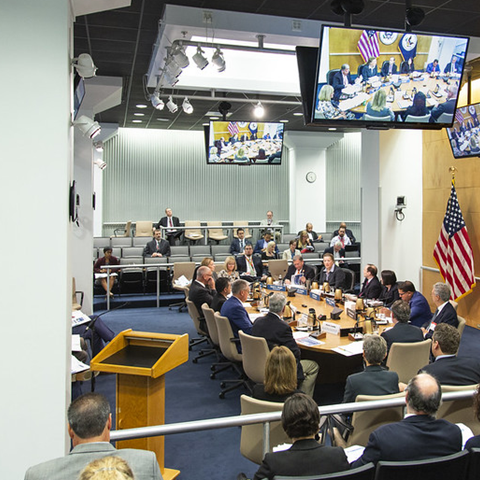
Pre-Application Engagement
Another critical aspect of Kairos Power’s regulatory strategy is very active pre-application engagement with the regulator. Over the past several years, pre-application engagement, while optional, has been broadly touted as essential to establish an efficient review of the license application itself. One primary benefit of such engagement is to familiarize the regulator with a design and to identify and address issues where knowledge gaps may exist.
Kairos Power also is taking maximum advantage of substantial discussions with the regulator to “front load” the engagement with early review of substantive topics to reduce programmatic risk. At this writing, Kairos Power has submitted over 20 technical or topical reports or revisions and has received formal approval by the regulator on a number of these submittals.
Evolving Regulatory Framework
Kairos Power’s approach also meshes well with ongoing efforts to update the U.S. regulatory framework to support non-LWR licensing. These include creating guidance to support a risk-informed safety case (in lieu of deterministic safety bases underlying current LWR guidance) and development of 10 CFR 53. While these efforts are important to long-term regulatory improvement and stability, near-term licensing efforts must focus on navigating through the existing framework.
This approach necessitates several deviations from past practice (owing to the LWR-centric nature of existing regulations and guidance), but these deviations – while somewhat cumbersome – are manageable. Further, there is a real symbiosis between near-term licensing efforts and ongoing work to update the regulatory framework to accommodate advanced reactors. As framework changes are proposed, often they can be “test driven” in actual licensing efforts, and as work proceeds, both the ongoing framework changes and the near-term licensing efforts can be adjusted to account for lessons learned. In a very real way, this approach also aligns very closely with Kairos Power’s iterative approach to development.
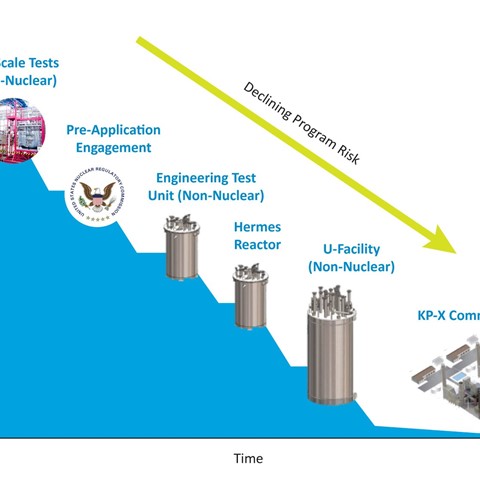
Retiring Risk Early
As discussed above, Kairos Power’s regulatory strategy includes substantive pre-application engagement with the regulator. This engagement includes regulatory staff review of numerous Kairos Power documents, plus submittal of several topical reports for formal review. These formal licensing submittals are selected to address key technical issues in an effort to identify any knowledge gaps or “hard spots” as part of the regulator’s review.
The key topics addressed in these submittals include selection of principal design criteria; analysis of regulatory gaps for non-LWRs; separate and integral effects test scaling; quality assurance; and licensing basis event selection and safety classification. These programmatic and analytical methodology documents are essential components of the approach to KP-FHR design, safety analysis, and licensing.
Additionally, and among the most important, the submittals also initiate regulatory review of molten salt coolant qualification; fuel qualification and performance; high-temperature materials qualification for both metallics and graphite; and radiological source term for accident analysis. Early regulatory review of a developer’s approach to fuel and materials qualification is a key aspect to early retirement of programmatic risk.
Reactor Coolant (Salt) Qualification Program
Specification limits and thermophysical properties of the KP-FHR reactor coolant, a key design feature that supports enhanced safety performance. NRC review is complete and the topical report has been approved; NRC review is in progress for the balance of the reports listed below.
High Temperature Materials Qualification Plan (Metallics)
Testing and modeling to qualify structural alloys used in the safety-related systems of the KP-FHR.
High Temperature Materials Qualification Plan (Graphite)
The testing to qualify structural graphite used in safety‐related KP-FHR systems.
Fuel Performance Analysis Methodology
The methodology and analytical codes used to conduct TRISO fuel performance analysis for the KP-FHR. It describes KP-FHR fuel behavior and modeling to predict performance under normal operating conditions, anticipated operational occurrences, design-basis events, and beyond-design-basis events.
Fuel Qualification Program
The qualification methodology for KP-FHR fuel, based in part on international and U.S. operating experience with TRISO fuel particles and extensive post-irradiation examination and safety testing of TRISO fuel particles by the Department of Energy as part of Advanced Gas Reactor (AGR) fuel development experiments.
Mechanistic Source Term
The methodology for evaluation of the KP-FHR mechanistic source term to be used to calculate radiological source terms for anticipated operational occurrences, design basis events, and design basis accidents, to be used to calculate offsite radiological dose consequences.
Technology risk
Apart from early retirement of programmatic risks related to licensing, Kairos Power is also very heavily invested in addressing technology risk. Kairos Power’s rapid iteration approach to development and testing accelerates test cycles to facilitate innovation and optimization. This approach leverages multiple design-build-test cycles with non-nuclear and nuclear systems prior to the first commercial reactor. Kairos Power is deeply committed to a culture that embraces iterative development, and enables an integrated design philosophy, testing program, and licensing approach to mitigate technical, licensing, manufacturing, and construction risk, and establish cost certainty through iterative hardware demonstrations.
Kairos Power’s progress is measured in terms of actual hardware. In only four years, apart from the significant amount of pre-application engagement with the regulator, Kairos Power also has established significant testing assets in numerous locations across the U.S.
- • The R-Lab (Rapid Analysis, Prototyping, and Iterative Design Laboratory) began operations in September 2018. Collocated with Kairos Power’s Alameda, CA headquarters, the R-Lab has supported numerous surrogate fluid and high-temperature materials tests, including circulating over one million scaled surrogate fuel pebbles.
- • The S-Lab (Salt Lab), also collocated in Alameda, was commissioned in mid-2020. It is the first modern testing facility dedicated to performing evaluations in a Flibe environment at temperature.
- • The T-Facility (Component Testing Facility), a dedicated 40,000 sq. ft facility for large-scale equipment qualification tests, was recently completed in Albuquerque, NM.
- • Also located at the Albuquerque facility, the Engineering Test Unit (ETU) will perform integrated testing of a select set of components in a non-nuclear and unenriched Flibe-wetted environment, supporting design integration, supply chain demonstration, and operations.
- • The Albuquerque facility also houses the Pebble Development Lab (PDL), a pebble manufacturing facility focused on producing non-nuclear fuel pebbles for the ETU and future non-nuclear iterations as well as demonstrating the manufacturing processes for Kairos’ unique fuel pebble form.
On the path to commercialization, Kairos Power also has determined that the best way to retire remaining programmatic risk is to deploy a small, non-power demonstration reactor – known as Hermes – that will be operating in Oak Ridge, Tennessee, in 2026. In keeping with Kairos Power’s iterative development approach, the scale of the ETU is approximately the same as Hermes, and ETU temperatures, pressures, and other operating parameters will be identical to Hermes. The Hermes reactor will further serve as a future test bed for qualification of more advanced fuels and structural materials for deployment in the future KP-FHR commercial reactors.
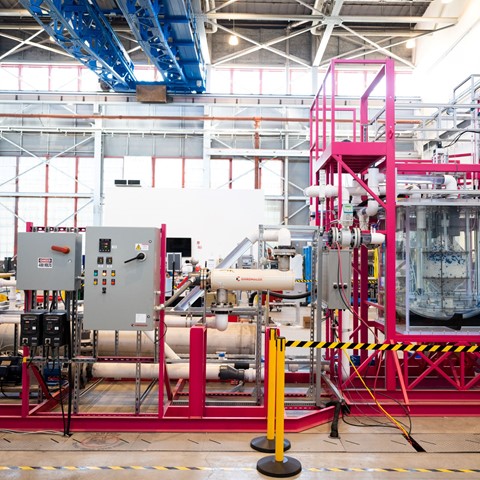
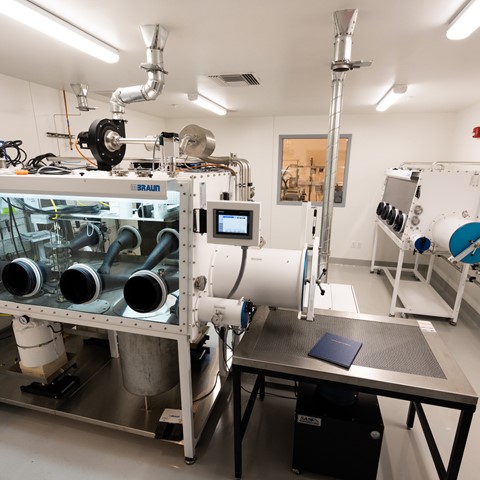
Conclusion
While advanced reactor licensing is perceived as particularly challenging, a thoughtfully designed and well-executed strategy can mitigate these challenges. Early and substantive engagement with the regulator can ameliorate the programmatic risks associated with new technology, novel regulatory approaches, and key technical risks.
The licensing regime may vary depending on jurisdictional vagaries, and in some cases the regulatory framework is evolving rapidly or even being established from the ground up. But a team familiar with the regulatory environment and dedicated to innovation can make it work, and Kairos Power’s experiences can be used to inform an approach that maximizes the likelihood of success.
